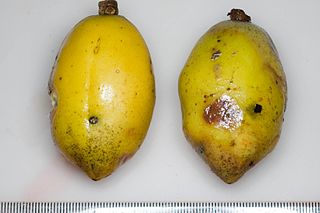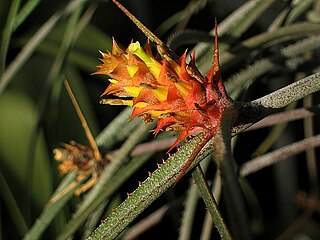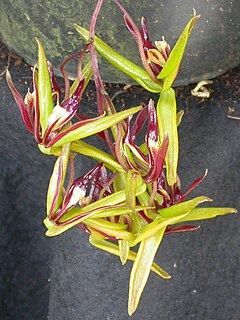Related Research Articles
Caryodendron is a plant genus of the family Euphorbiaceae first described as a genus in 1860. The genus includes C. orinocense, known as the Inchi tree or Tacay nut. It is native to Central America and South America.
- Caryodendron amazonicumDucke - Amazonas in Brazil
- Caryodendron angustifoliumStandl. - Costa Rica, Panama, Colombia
- Caryodendron janeirenseMüll.Arg. - Rio de Janeiro
- Caryodendron orinocenseH.Karst - Colombia, Venezuela, Ecuador
Angostylis is a genus of flowering plants in the family Euphorbiaceae, first described in 1854. The genus is native to northern South America.

Glycydendron is a genus of plants, under the family Euphorbiaceae first described as a genus in 1922. It is native to South America.
- Glycydendron amazonicumDucke - French Guinea, Suriname, Guyana, Ecuador, Peru, Bolivia, northwestern Brazil, possibly Colombia
- Glycydendron espiritosantenseKuhlm, - State of Espirito Santo in Brazil
Algernonia is a plant genus of the family Euphorbiaceae first described as a genus in 1858. It is native to Peru and Brazil.

Campomanesia is a genus in the family Myrtaceae described as a genus in 1794. It is native to South America and Trinidad.

Acanthostachys is a genus of the botanical family Bromeliaceae, subfamily Bromelioideae. The genus name is from the Greek “acanthos” and “stachys”.
Cottendorfia is a genus of plants in the family Bromeliaceae. The genus name is for Johann Georg Freiherr Cotta von Cottendorf, German patron of the sciences (1796-1863).

Cirrhaea is a genus of orchids, comprising 7 recognized species, all endemic to Brazil.

Araujia is a small genus of perennial vines in the dogbane family first described as a genus in 1817. The group is native to South America.
- Araujia angustifolia(Hook. & Arn.) Steud. - Brazil, Paraguay, Uruguay, NE Argentina
- Araujia graveolens(Lindl.) Mast. - Brazil
- Araujia herzogii(Schltr.) Fontella & Goyder - Bolivia
- Araujia hortorumE.Fourn. - Brazil, Paraguay, Uruguay, NE Argentina
- Araujia megapotamica(Spreng.) G.Don - Brazil, Uruguay, NE Argentina
- Araujia plumosaSchltr. - Brazil, Paraguay, Bolivia, NW Argentina
- Araujia sericiferaBrot. - white bladderflower, cruel vine - Peru, Brazil; naturalized in parts of South Africa + United States
- Araujia stuckertiana(Kurtz ex Heger) Fontella & Goyder - Cordoba in Argentina
- Araujia subhastataE.Fourn. - Brazil
Mangonia is a genus of flowering plants in the family Araceae. The genus contains only two known species native to southern Brazil and Uruguay.
- Mangonia tweedieanaSchott. - Rio Grande do Sul, Uruguay
- Mangonia uruguaya(Hicken) Bogner - Cerro Largo in Uruguay

Cycnoches haagii is a species of orchid native to tropical South America.
Dissothrix is a genus of flowering plants in the daisy family, Asteraceae.

Albertinia is a genus of flowering plants in the daisy family described as a genus in 1820.

Bixa is a genus of plants in the family Bixaceae. It is native to Mexico, Central America, Caribbean, and South America, and naturalized in other places.
Bradea is a genus of flowering plants in the family Rubiaceae. It was first described by Paul Carpenter Standley in 1932 and is named after the German botanist Alexander Curt Brade. All 6 species are endemic to Brazil, hence the name of the type species.
Eriothymus is a genus of flowering plant in the family Lamiaceae, first described as a genus in 1835. It contains only one known species, Eriothymus rubiaceus. It is endemic to the State of Minas Gerais in Brazil.
Hoehnea is a genus of plants in the family Lamiaceae, first described with this name in 1939. It is native to South America, primarily southern Brazil.
Bahiella is a genus of plants in the family Apocynaceae first described as a genus in 2006. The entire group is endemic to the State of Bahia in northeastern Brazil, the state after which the genus is named.
Hypolobus is a species of plants in the family Apocynaceae first described as a genus in 1885. It contains only one known species, Hypolobus infractus, endemic to the State of Bahia in Brazil.
Petalostelma is a genus of flowering plants in the family Apocynaceae, first described as a genus in 1885. They are native to South America.
References
- ↑ Fournier, Eugène Pierre Nicolas. 1885. in Martius, Carl Friedrich Philipp von (ed), Flora Brasiliensis 6(4): 290 in Latin
- ↑ Forzza, R. C. 2010. Lista de espécies Flora do Brasil "Archived copy". Archived from the original on 2015-09-06. Retrieved 2015-08-20.CS1 maint: archived copy as title (link). Jardim Botânico do Rio de Janeiro, Rio de Janeiro
| | This Apocynaceae article is a stub. You can help Wikipedia by expanding it. |